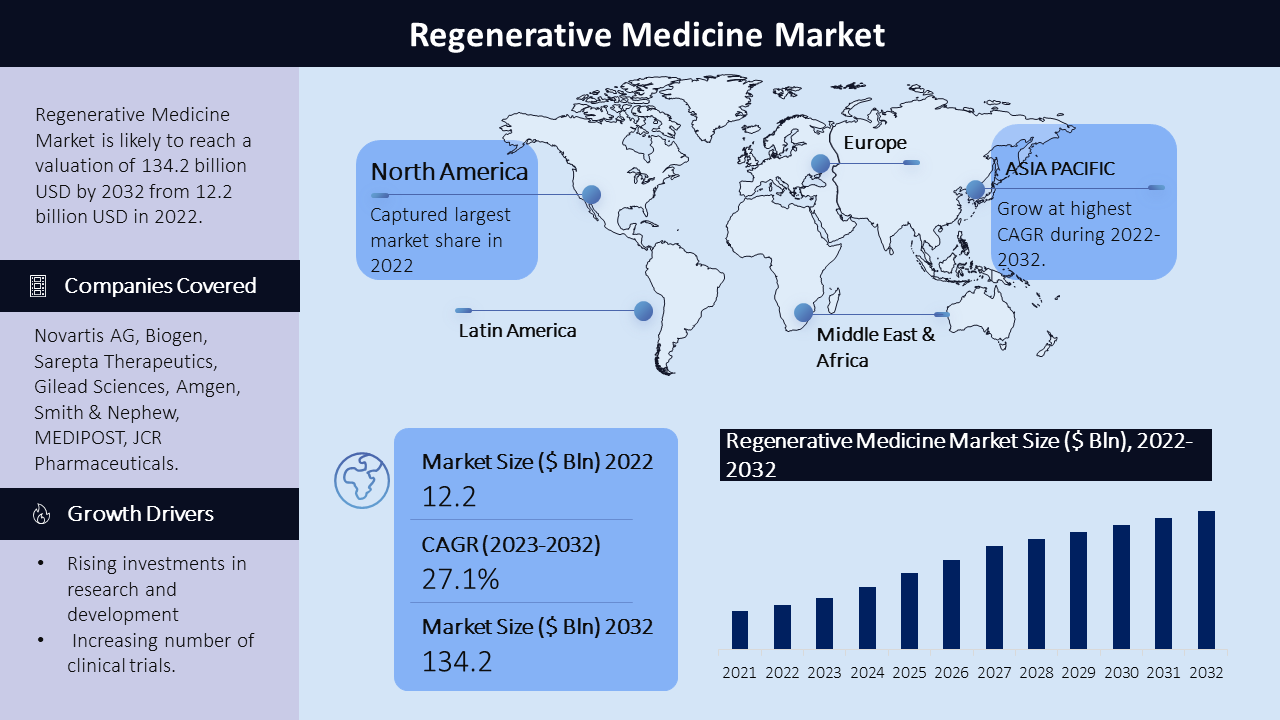Regenerative Medicine Market - Global Size, Share, Trends, Growth and Forecast Year ( 2022 – 2032 )
Regenerative Medicine Market :
The global regenerative medicine market witnessed remarkable growth, with a projected revenue of $12.2 billion in 2022, expected to reach $134.2 billion by 2032, growing at a CAGR of 27.1% during the forecast period. The market is driven by factors such as increased funding and investments in research and development, a rise in clinical trials for stem cell and CAR-T cell therapies, and advancements in tissue-engineered products. However, challenges like high treatment costs and issues related to commercialization and regulatory compliance may hinder market growth. The market is full of attractive opportunities, and key players in the industry are focusing on product innovation and strategic collaborations to gain a competitive edge. The market encompasses various product types and applications, including cell therapies, gene therapies, tissue engineering, and more. Key players in the market are actively engaged in research and development activities to develop novel therapies and enhance their market presence.
Market Segmentation:
Product Type:
- Gene Therapy
- Cell Therapy
- Stem Cell Therapy
- Autologous Therapy
- Allogenic Therapy
- Cell-Based Immunotherapy Products
- Cord Blood/Progenitor Cell Therapies
- Tissue Engineering
- Scaffolds
- Hydrogels
- Collagen
- Others
Applications:
- Musculoskeletal Disorders
- Oncology
- Dermatology & Wound Care
- Ophthalmology
- Cardiovascular Diseases
- Others
Geographic Regions:
- North America
- Europe
- Asia Pacific
- Latin America
- Middle East and Africa
Cell Therapies: Among the different product types, cell therapies hold the largest market share in the regenerative medicine market. Cell therapies involve the transplantation or implantation of cells to replace or repair damaged tissues or organs. The increasing approvals for GMP-certified cell therapy production facilities and advancements in cell-based immunotherapy products have contributed to the dominance of this segment.
Musculoskeletal Disorders: In terms of applications, the musculoskeletal disorders segment accounts for the largest market share. Regenerative medicine offers potential solutions for the treatment of orthopedic conditions and the regeneration of musculoskeletal tissues. The rising prevalence of musculoskeletal disorders, coupled with the advancements in regenerative medicine technologies, has fueled the demand in this segment.
Regional Analysis:
North America dominates the global regenerative medicine market, accounting for the largest market share. The region's growth can be attributed to the presence of key market players, increasing stem cell banking, tissue engineering, and drug discovery activities. Furthermore, the high adoption of stem cell therapy and cell immunotherapies for cancer and chronic disease treatment contributes to market expansion in North America. Europe is another significant market for regenerative medicine, with countries like Germany, France, and the United Kingdom at the forefront. The region showcases substantial growth due to advancements in research and development, a supportive regulatory framework, and a growing emphasis on personalized medicine. The Asia Pacific region exhibits immense growth potential in the regenerative medicine market. Rising healthcare infrastructure, increasing investments in research and development, and a large patient pool contribute to market expansion in this region. Countries like Japan, India, and China are leading contributors to the growth of the regenerative medicine market in the Asia Pacific. Latin America and the Middle East & Africa are witnessing steady growth in the regenerative medicine market. Factors such as increasing healthcare expenditure, improving healthcare infrastructure, and a growing focus on advanced therapies contribute to market growth in these regions.
Growth Drivers:
The regenerative medicine market is primarily driven by the availability of funding and rising investments in research and development. The increasing need for improved therapies for various diseases, such as cancer, diabetes, and cardiovascular diseases, has led to a surge in research activities in the field of regenerative medicine. Consequently, funding for regenerative medicine research has increased, facilitating the development of new cell therapies, gene therapies, and tissue-engineered products.
Another significant growth driver is the increasing number of clinical trials for stem cell and CAR-T cell therapies. These innovative treatments show promising results in addressing various diseases and disorders, leading to increased adoption and investment in clinical trials. Advancements in tissue-engineered products also contribute to market growth. The development of sophisticated scaffolds, hydrogels, and other tissue-engineered materials has opened up new possibilities for regenerative medicine applications, driving market expansion.

Challenges:
The high treatment cost of regenerative medicine therapies poses a challenge to market growth. The complex manufacturing processes and specialized infrastructure required for these therapies contribute to their high cost. Additionally, issues related to commercialization and regulatory compliance can impede market growth in some regions.
Key Companies:
Leading players in the global regenerative medicine market include Novartis AG, Biogen, Sarepta Therapeutics, Gilead Sciences, Amgen, Smith & Nephew, MEDIPOST, JCR Pharmaceuticals, Takeda Pharmaceutical, CORESTEM, and others. Their competitive strategies involve product innovation, strategic partnerships, mergers, and acquisitions to enhance their market share and cater to diverse customer needs.
In 2022, MiMedx introduced Axiofill, an Extracellular Matrix (ECM) Particulate derived from human placental tissue. This innovative product offers surgical recovery solutions by utilizing human placental-derived particles.
January 6, 2021, Novartis announced a collaboration with Alnylam to utilize Alnylam's proven, proprietary siRNA technology for inhibiting a target identified at the Novartis Institutes for BioMedical Research. The collaboration aimed to potentially develop a treatment that promoted the regrowth of functional liver cells and provided an alternative to transplantation for patients with liver failure.

Need Customized Report for Your Business ?
Utilize the Power of Customized Research Aligned with Your Business Goals
Request for Customized Report- Quick Contact -
- ISO Certified Logo -

















